A DIP IN THE OCEAN
Demanding, daunting 5km ocean swim proved to be inspirational ‘60s spectacle
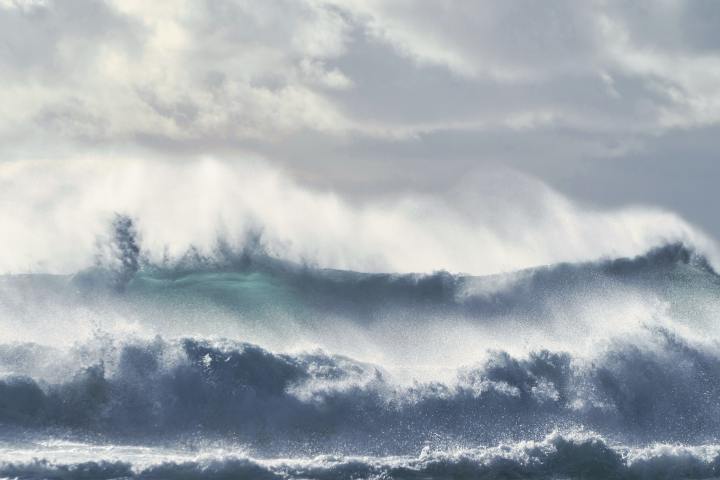
Back in 1964, the dailies reported some 70,000 spectators thronging the beaches and vantage points along the Fish Hoek stretch of coastline.
Two of the seven South Africans attempting an English Channel crossing have raised land. One has failed. Four to go. In the meantime, a flier for an old swim has been doing the rounds on social media — a sepia-toned ad for the 1964 Fish Hoek to Muizenberg Marathon Swim, organised by the Western Province Surf Life Saving Association and the Amateur Swimming Association, for the Jantzen trophy.
It sparked some wonderful memories.
25 January 1964: A Saturday morning. Kay Bales remembers that 5km swim particularly well. That was the swim where she sat on the beach for hours with a three-month-old baby in her arms (her first son, Tony, now in his sixties), and her new husband’s mother angrily berating Kay for letting her husband enter such a foolish event.
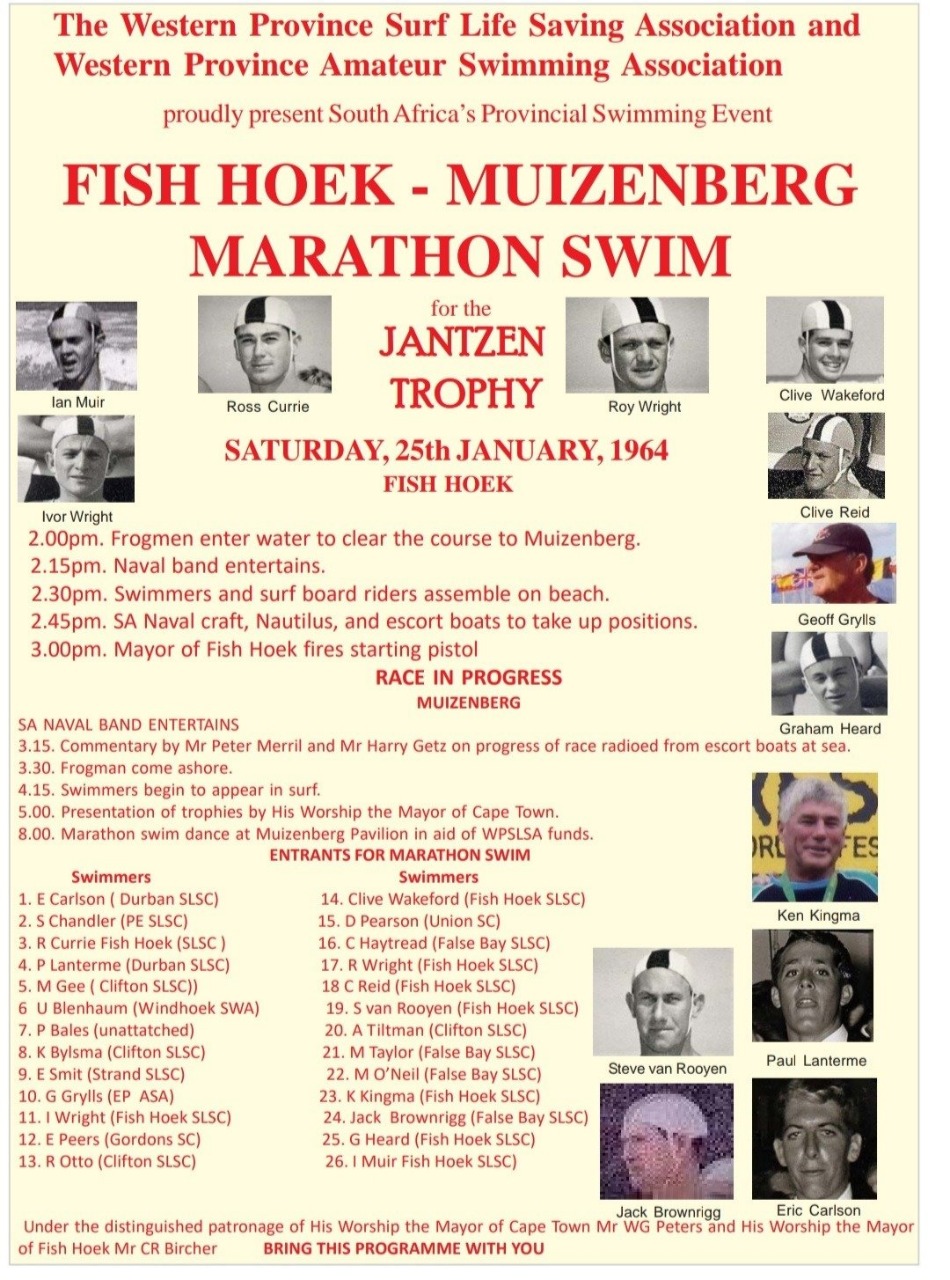
Fish Hoek to Muizenberg Marathon Swim poster. Image: Supplied
It was a huge spectacle. This sea swimming thing had stunned a rapt audience. The dailies ran berserk with a predator-porn sort of fascination, a glitch which has lurked at the back of our lizard-brain cortexes since the first mammals crept, trembling, out of their bolt-holes into a post-dinosaur world.
That aside, it was newsworthy, nonetheless. The dailies reported some 70,000 spectators thronging the beaches and vantage points along that stretch of coastline.
And it was the first sea swim for Peter — Kay’s husband of a year and a half. (Peter would in five years go on to found the Cape Long Distance Swimming Association (CLDSA), an organisation now in its sixth decade, dedicated to recording and preserving open-water swimming lore.) No one knew anything about open-water swimming in those days; it just wasn’t a done thing. But Peter had gone and entered anyway, Kay says. Someone had dared him and there we were.
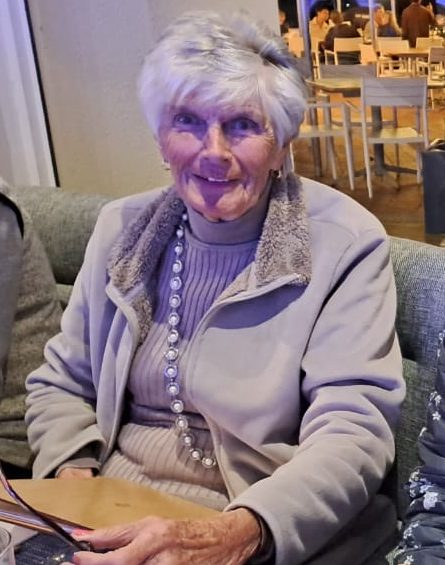
Kay Bales. Image: Supplied
Well, the day had dawned with the filthiest south-easter in living memory. The Navy had been brought in to assist with logistics, but they were so far out to sea you couldn’t see them. They had anchored their frigate about a kilometre and a half off Muizenberg beach as the first “buoy” for swimmers to swim around.
All the swimmers had been issued with red swim caps to allow family and friends standing on Boyes Drive to track their progress. That was the idea, at least.
“All you could see was this terrible white water and huge waves,” remembers Kay. “I thought Peter was nuts at the best of times, which on that day he actually was. It was a very difficult day. Everyone on land was terrified that their swimmer had been lost. There was all sorts going on!”
Peter’s mother had also been unimpressed. “She was very, very cross. She kept saying, ‘The bloody fool! What’s gotten into his head’, and you did have to wonder what had gotten into anybody’s head that morning,” Kay adds.
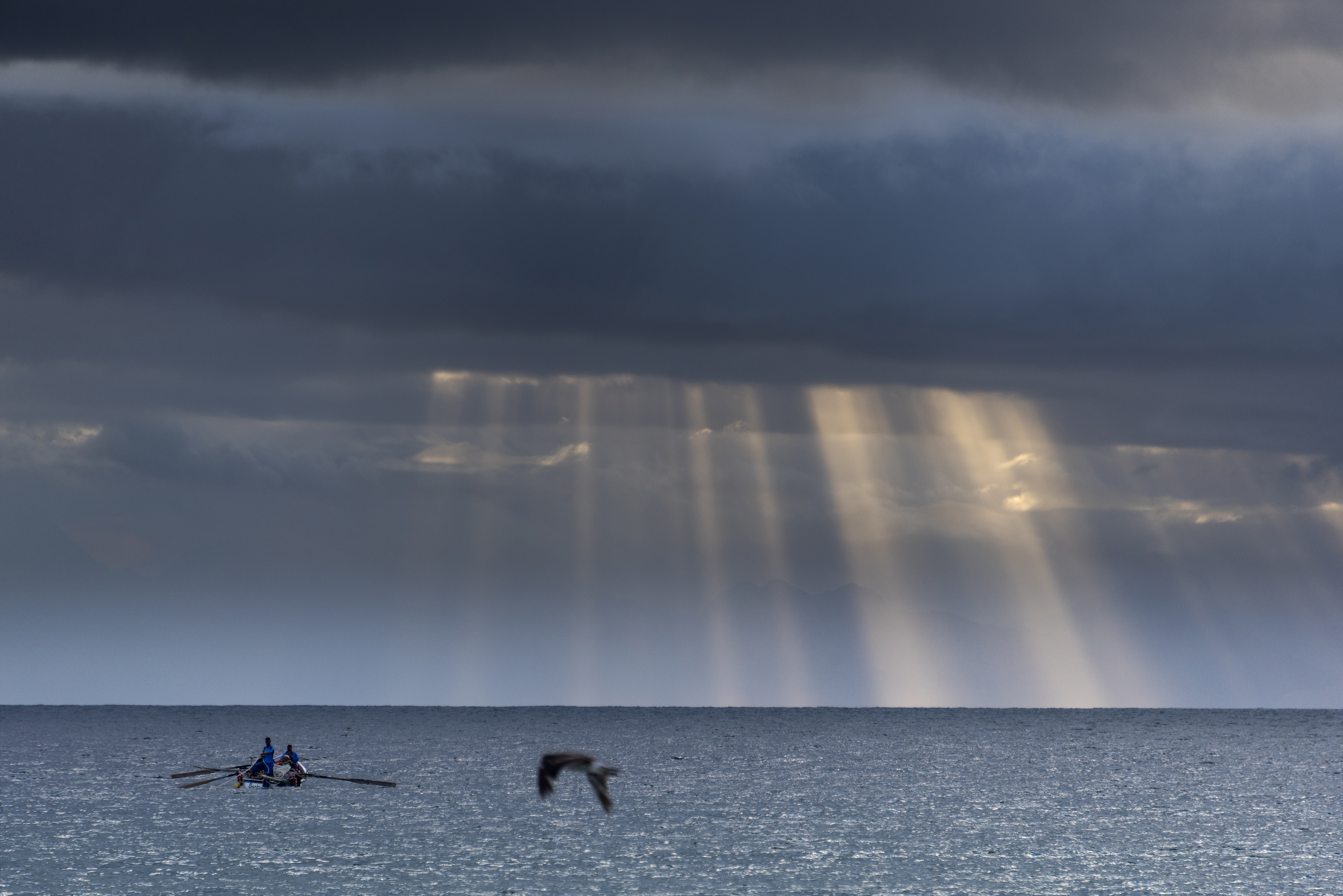
Early morning trek boat in search of Yellowtail shoals. False Bay, Cape Town, South Africa. Image: Gallo Images / Kenneth Gerhardt
Finally, a broadcast system was set up reporting back from the Navy frigate and informing people on the beach when their swimmer had rounded the ship. “The announcement came, Peter Bales has gone round. I’d been waiting forever to hear that. And then it took another hour for him to get back to shore! I was so pleased to see him! But the reception from his mother was a bit frosty, too!”
Peter remembers his thoughts shifting from winning the race to pure survival.
“There were no safety boats, or if there were boats they couldn’t see the swimmers. It was rough seas and very cold, and you were out there on your own. Quite frightening, and very lucky there were no disasters that day,” he says.
Another entrant, Bantry Bay’s Paul Lanterme (79), born in Durban, Springbok Lifesaver and Ironman specialist, also remembers that morning. He was 20 years old, and he’d swum the inaugural event in 1962, also on a day with a howling south-easter, but had pulled out at Kalk Bay as it was too rough to continue swimming. Then again in 1963, and now this was his third time with another banshee wind whipping up the water.
“It was a howling south-easter. Again! I remember looking at the guys lined up next to me on the beach. I’d never seen such okes. One guy next to me looked like he’d swallowed a Weber he was so out of shape. Then we heard, that, Jeez, this one oke from the then South West Africa was going to swim breaststroke. I mean, we were like, how is that even possible!”
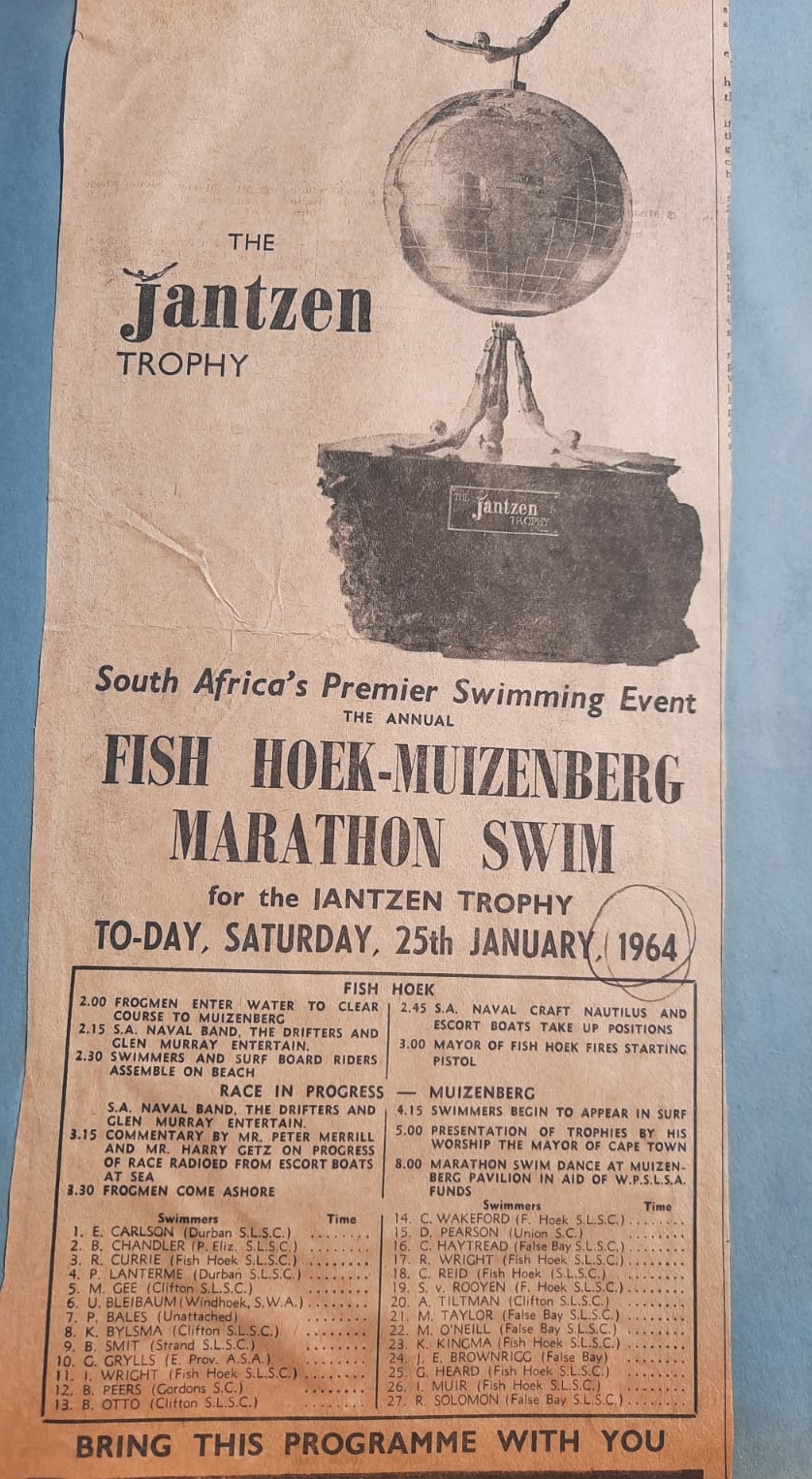
Newspaper clipping of the Jantzen trophy. Image: Supplied
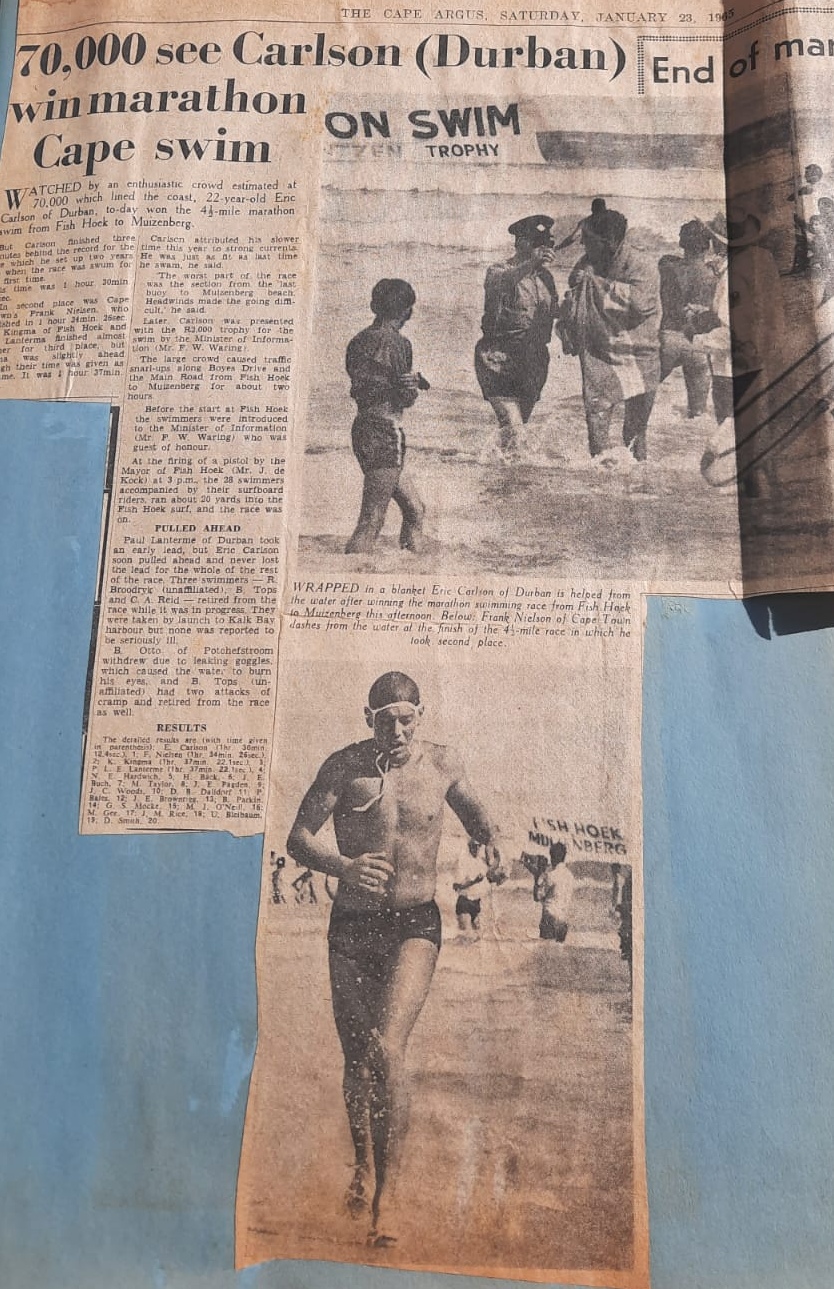
A clipping from the Cape Argus. Image: Supplied
Lanterme, who tied for third in that swim, says that these days people swim to Robben Island before tea, but in those days a 5km swim was classed as a marathon swim. Nobody had ever done that sort of thing before. The newspapers went wild. There were pics everywhere. Tens of thousands of spectators wanting to catch a glimpse of these superheroes. Reporters like cats who got the cream.
“You do ask yourself, where have all the crowds gone?,” Kay ponders wistfully.
A couple of years later, the Cape Argus organised a Robben Island to Woodstock Beach race. It would be Peter’s first island attempt. But the inexperienced skippers on the support boats had no idea they were supposed to stick close to their swimmer, Kay says. The swimmers started going off in different directions. At one stage, Pete’s skipper was 200m ahead of him fishing for snoek!
And when Peter finally got to shore, he made the mistake of touching the Strand Road pier, and was promptly disqualified. Race rules state that you have to start and finish on land. No man-made structures.
And then the race winner Frankie Nielsen, chirpy as crickets, boasted to the crowd that he would now take on the English Channel.
“If that bloody man had just kept his mouth shut”, says Kay, her big lummox of a husband wouldn’t have risen to the challenge and vowed to swim the English Channel too. “Pete being Pete, said, ‘Well, bugger that, I’ll do it too!’ And three months later, [self-financed] he went!”
And became the first South African to swim the Channel. DM/ ML
In case you missed it, also read The day Annemie Landmeters swam across False Bay
Visit Daily Maverick’s home page for more news, analysis and investigations

















 Become an Insider
Become an Insider
Comments - Please login in order to comment.